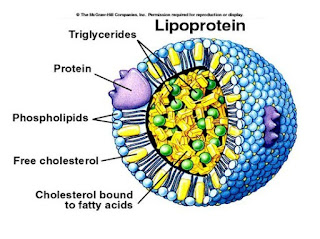Lipoproteins
Plasma lipids contain triacylglycerols, cholesterol and other polar lipids.Lipids combined with
apolipoproteins to form Lipoproteins. Based on their density they are classified into four
subgroups:
Chylomicrons:
These are derived from intestinal absorption of triacylglycerols and other lipids and have a very
short lifespan. They have the least density and richly consist TAG. Chylomicrons transport dietary
triacylglycerols and cholesterol from the intestine to the liver for metabolism.
VLDL (very low density lipoproteins):
These are synthesized in the liver and used to transport triacylglycerols from the liver to
extrahepatic tissues.
LDL (Low density lipoproteins):
These are produced from the final stage in the catabolism of VLDL. They transport cholesterol
synthesized in the liver to peripheral tissues. LDL is metabolized via the LDLreceptorApproximately 30% of the LDL is degraded in extra hepatic tissues, rest is degraded in
liver.
HDL (High Density Lipoproteins):
HDL has the highest density in this group since it contains more protein and cholesterol than
triacylglycerols. It transports excess cholesterol from peripheral tissues to the liver for degradation
and removal. Therefore, HDL cholesterol is good cholesterol but LDL cholesterol is called bad
cholesterol.
High concentration of circulating VLDL,LDL are indicative of possible atherosclerosis .Elevated
HDL is a good sign which indicates less chances of atherosclerosis .There is a correlation
between the incidence of coronary heart disease and low level of HDL.The higher the ratio of
HDL/LDL, the less the chances of CHD .
Lipids and Membranes
Membranes are important biological structures, which are indispensable for life. Membranes give
cells their individuality by separating them from their surrounding and they are highly selective
and semi permeable containing specific gates, pumps, and channels. Membranes control the flow
information between cells and their environment since they contain specific receptor molecules in
the form of glycoproteins.
Chemical Composition of Membranes
Phospholipids are the major class of membrane lipids. Cholesterol, glycoproteins and glycolipids
are also the other components of membranes. Glycerophospholipids like lecithin, cephalin and
phosphatidyl serine. Membranes are mainly formed of phospholipid bilayers. Sphingolipids also
form membrane structures, especially that of the brain cells and nerve cells.
Structure of Membranes
All membranes have a bimolecular leaf of lipid bilayers. Proteins are found submerged in the sea
of the lipid bilayers (intrinsic proteins) or loosely bound (extrinsic proteins) and cholesterol is also
found intercalated between the lipid bilayers giving the fluidy nature of membranes. The integral
proteins contain sugar oligomers and most of them function as receptors. Some of the
characteristic features of membranes are listed below.
Membranes can be regarded as a sea of lipid bilayers and due to the presence of unsaturated
fatty acids and cholesterol. This fluidity enables lateral diffusion of molecules such that integral
and non-integral proteins span the whole membrane structure. This implies that membranes are
not rigid structures but dynamic structures. The modern representation of lipids as fluidy and
dynamic structures is called the fluid mosaic model. The molecules forming membrane structures
do not flip-flop or undergo traverse diffusion and therefore, membranes are asymmetric
structurally and functionally. The outer and inner surfaces of all known biological membranes
have different components and different enzymatic activities.
